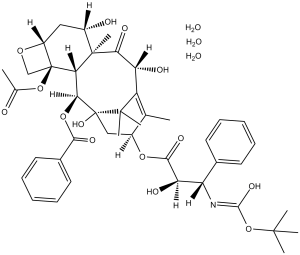Docetaxel Trihydrate (RP 56976)
This product is for research use only, not for human use. We do not sell to patients.

For small sizes, please check our retail website as below: www.invivochem.com
| Size | Price | Stock |
|---|---|---|
| 1g | $250 | Check With Us |
| 10g | $950 | Check With Us |
| 20g | $1425 | Check With Us |
Cat #: V1611 CAS #: 148408-66-6 Purity ≥ 98%
Description: Docetaxel Trihydrate (formerly RP-56976; NSC-628503; trade name Taxotere), the trihydrated form of docetaxel which is a paclitaxel analog, is a tubulin/mitotic inhibitor with a broad spectrum of antineoplastic activities.
Top Publications Citing Invivochem Products
Publications Citing InvivoChem Products
Product Promise

- Physicochemical and Storage Information
- Protocol
- Related Biological Data
- Stock Solution Preparation
- Quality Control Documentation
| Molecular Weight (MW) | 861.93 |
|---|---|
| Molecular Formula | C43H53NO14.3H2O |
| CAS No. | 148408-66-6 |
| Storage | -20℃ for 3 years in powder formr |
| -80℃ for 2 years in solvent | |
| Solubility In Vitro | DMSO: 100 mg/mL (116.0 mM)r |
| Water:<1 mg/mLr | |
| Ethanol: 100 mg/mL (116.0 mM) | |
| Synonyms | RP56976 (NSC 628503) Trihydrate; RP56976; NSC 628503; RP-56976; NSC628503; RP 56976; NSC-628503; Docetaxel trihydrate, Trade name: Taxotere. |
| Protocol | In Vitro | Single and combined treatments of Docetaxel Trihydrate (RP-56976 Trihydrate) and Glufosfamide (GLU) affect cell viability in a dose-dependent manner. IC of GLU in PC-3 and LNCaP cells5070±4 μM and 86.8±8 μM, respectively; Separately. Meanwhile, in PC-3 and LNCaP cells, Docetaxel's IC alone was used50 They are 3.08±0.4 nM and 1.46±0.2 nM, respectively. GLU is processed in conjunction with Docetaxel to enable IC in PC-3 and LNCaP cells50 Values reduced to 2.7±0.1 nM and 0.75±0.3 nM, respectively; separately |
|---|
These protocols are for reference only. InvivoChem does not
independently validate these methods.
| Solvent volume to be added | Mass (the weight of a compound) | |||
|---|---|---|---|---|
| Mother liquor concentration | 1mg | 5mg | 10mg | 20mg |
| 1mM | 1.1602 mL | 5.8009 mL | 11.6019 mL | 23.2037 mL |
| 5mM | 0.2320 mL | 1.1602 mL | 2.3204 mL | 4.6407 mL |
| 10mM | 0.1160 mL | 0.5801 mL | 1.1602 mL | 2.3204 mL |
| 20mM | 0.0580 mL | 0.2900 mL | 0.5801 mL | 1.1602 mL |
The molarity calculator equation
Mass(g) = Concentration(mol/L) × Volume(L) × Molecular Weight(g/mol)
Mass
=
Concentration
×
Volume
×
Molecular Weight*
The dilution calculator equation
Concentration(start)
×
Volume(start)
=
Concentration(final)
×
Volume(final)
This equation is commonly abbreviated as: C1 V1 = C2 V2
Concentration(start)
C1
×
Volume(start)
V1
=
Concentration(final)
C2
×
Volume(final)
V2
Step One: Enter information below
Dosage mg/kg
Average weight of animals g
Dosing volume per animal µL
Number of animals
Step Two: Enter the in vivo formulation
%DMSO
+
%
+
%Tween 80
+
%ddH2O
Calculation Results:
Working concentration:
mg/ml;
Method for preparing DMSO master liquid:
mg
drug pre-dissolved in
µL
DMSO(Master liquid concentration
mg/mL)
,Please contact us first if the concentration exceeds the DMSO solubility of the batch of drug.
Method for preparing in vivo formulation:
Take
µL
DMSO master liquid, next add
µL
PEG300, mix and clarify, next add
µL
Tween 80,mix and clarify, next add
µL
ddH2O,mix and clarify.
Note:
- (1) Please be sure that the solution is clear before the addition of next solvent. Dissolution methods like vortex, ultrasound or warming and heat may be used to aid dissolving.
- (2) Be sure to add the solvent(s) in order.




































